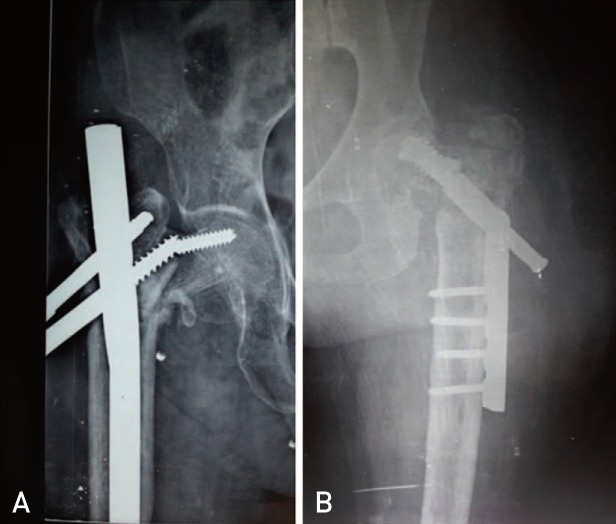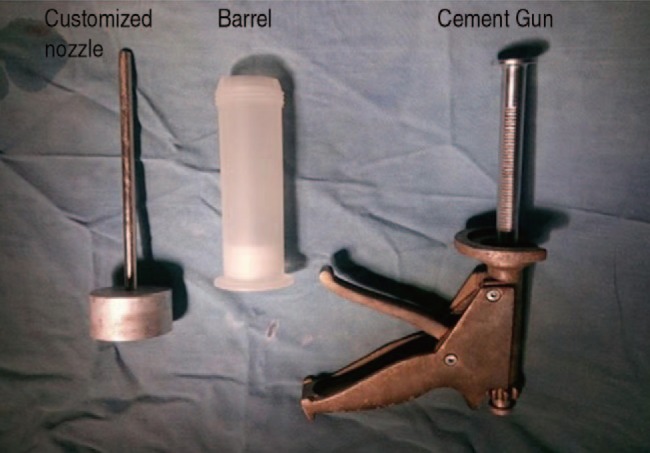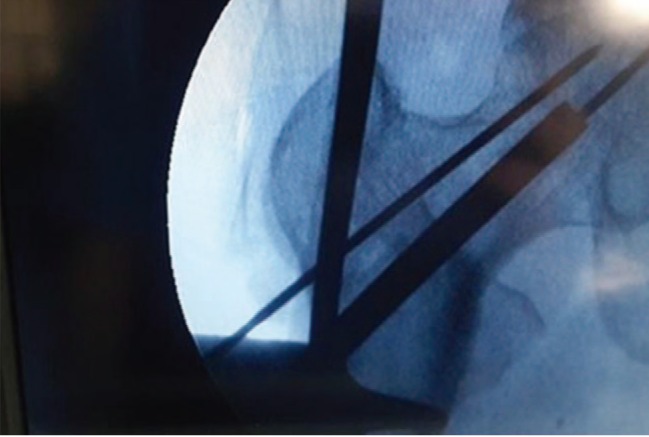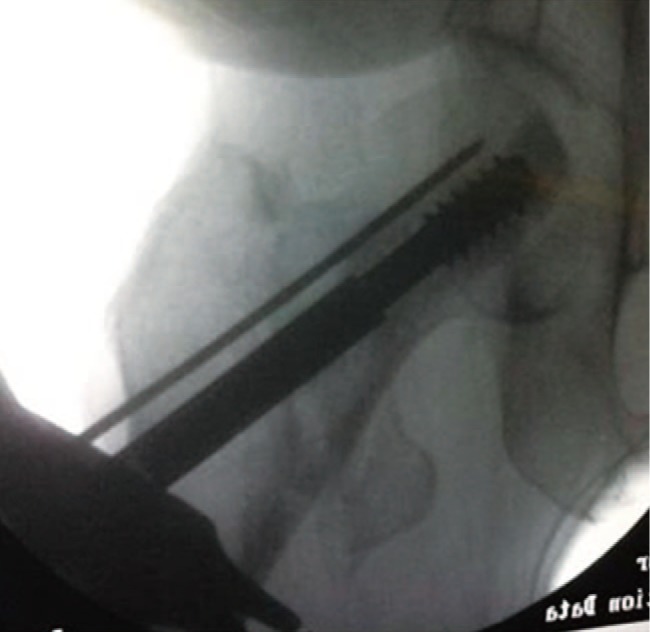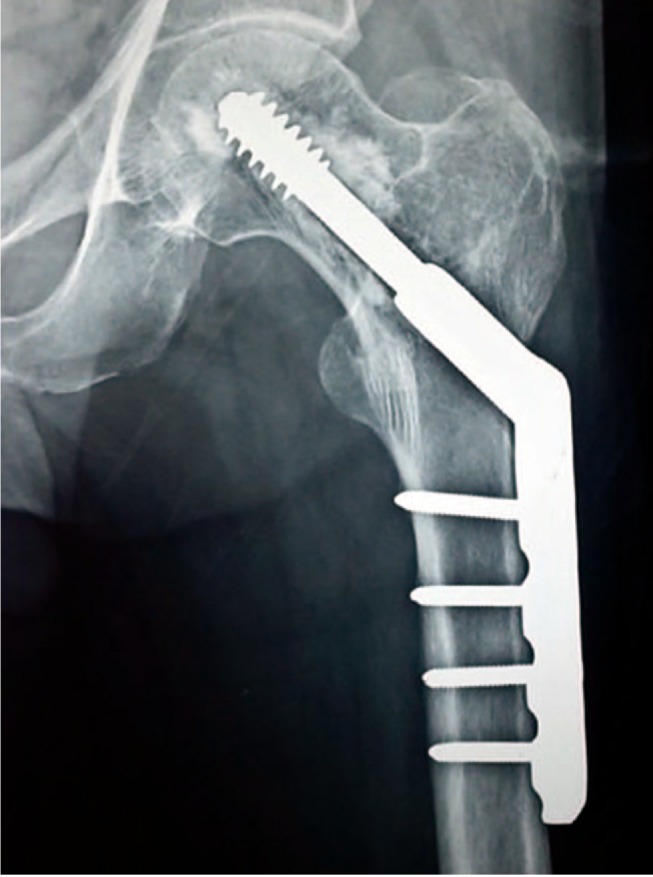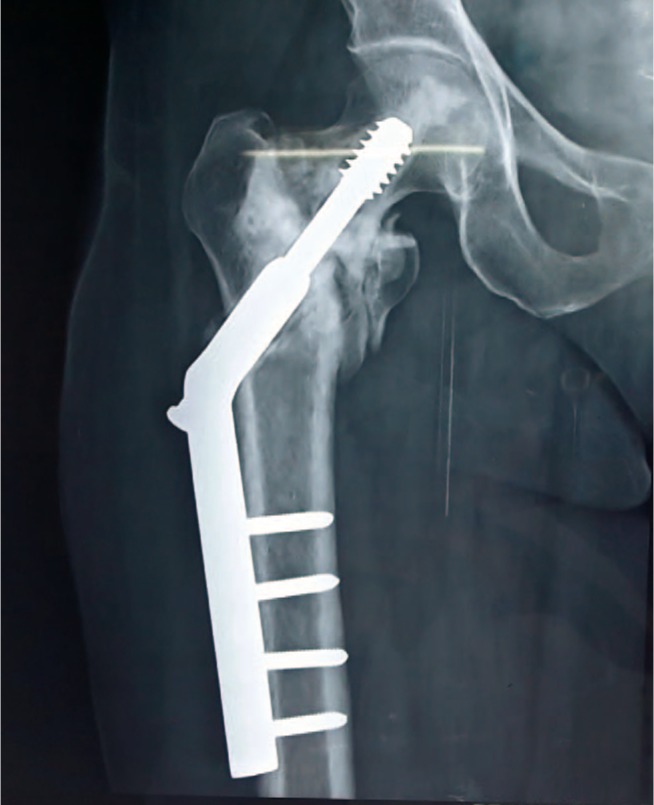Hip Pelvis.
2018 Dec;30(4):269-275. 10.5371/hp.2018.30.4.269.
Cement Augmentation of Dynamic Hip Screw to Prevent Screw Cut Out in Osteoporotic Patients with Intertrochanteric Fractures: A Case Series
- Affiliations
-
- 1Department of Orthopaedics, Government Medical College, Kota, India. dravinashrai26@gmail.com
- KMID: 2427931
- DOI: http://doi.org/10.5371/hp.2018.30.4.269
Abstract
- PURPOSE
The purpose of this study is to describe a method of inserting cement in the femoral head before fixation with dynamic hip screw to prevent screw cut out due to osteoporosis and to evaluate its clinical outcome in these patients.
MATERIALS AND METHODS
In this prospective study, 30 patients aged 60 years and older with intertrochanteric fracture were included. Bone mineral density was measured. After reaming of the femoral head and neck with a triple reamer and polymethyl methacrylate, bone cement was introduced into the femoral head using a customized nozzle and a barrel fitted on a cement gun. A Richard screw was inserted and the plate was fixed over the femoral shaft. Patients were mobilized and clinical outcomes were rated using the Salvati and Wilson's scoring system.
RESULTS
More patients included in this study were between 66 and 70 years old than any other age group. The most common fracture according to the Orthopaedic Trauma Association classification was type 31A2.2 (46.7%). The T-score was found to be −2.506±0.22 (mean±standard deviation); all patients were within the range of −2.0 to −2.8. The duration of radiological union was 13.67±1.77 weeks. Salvati and Wilson's scoring at 12 months of follow up was 30.96±4.97. The majority of patients were able to perform their normal routine activities; none experienced implant failure or screw cut out.
CONCLUSION
Bone cement augmentation may effectively prevent osteoporosis-related hardware complications like screw cut out in elderly patients experiencing intertrochanteric fractures.
Keyword
MeSH Terms
Figure
Reference
-
1. Kaufer H. Mechanics of the treatment of hip injuries. Clin Orthop Relat Res. 1980; (146):53–61. PMID: 7371269.
Article2. Broderick JM, Bruce-Brand R, Stanley E, Mulhall KJ. Osteoporotic hip fractures: the burden of fixation failure. Scientific World Journal. 2013; 2013:515197. PMID: 23476139.
Article3. Giannoudis PV, Schneider E. Principles of fixation of osteoporotic fractures. J Bone Joint Surg Br. 2006; 88:1272–1278. PMID: 17012413.
Article4. Choueka J, Koval KJ, Kummer FJ, Crawford G, Zuckerman JD. Biomechanical comparison of the sliding hip screw and the dome plunger. Effects of material and fixation design. J Bone Joint Surg Br. 1995; 77:277–283. PMID: 7706347.
Article5. Giannoudis PV, Schneider E. Osteoporosis. In : Ruedi T, Buckley R, Morgan CG, editors. AO Principles of fracture management. 2nd ed. Stuttgart: Thieme;2007. p. 469–482.6. Seebeck J, Goldhahn J, Morlock MM, Schneider E. Mechanical behavior of screws in normal and osteoporotic bone. Osteoporos Int. 2005; 16(Suppl 2):S107–S111. PMID: 15517184.
Article7. Tencer AF. Mechanics of internal fixation of bone. In : An YH, editor. Internal fixation in osteoporotic bone. New York: Thieme Medical Publisher;2002. p. 42–45.8. Choueka J, Koval KJ, Kummer FJ, Zukerman JD. Cement augmentation of intertrochanteric fracture fixation: a cadaver comparison of 2 techniques. Acta Orthop Scand. 1996; 67:153–157. PMID: 8623570.9. Gupta RK, Gupta V, Gupta N. Outcomes of osteoporotic trochanteric fractures treated with cement-augmented dynamic hip screw. Indian J Orthop. 2012; 46:640–645. PMID: 23325965.
Article10. Lee PC, Hsieh PH, Chou YC, Wu CC, Chen WJ. Dynamic hip screws for unstable intertrochanteric fractures in elderly patients--encouraging results with a cement augmentation technique. J Trauma. 2010; 68:954–964. PMID: 20386288.
Article11. Bartucci EJ, Gonzalez MH, Cooperman DR, Freedberg HI, Barmada R, Laros GS. The effect of adjunctive methylmethacrylate on failures of fixation and function in patients with intertrochanteric fractures and osteoporosis. J Bone Joint Surg Am. 1985; 67:1094–1107. PMID: 4030829.
Article12. Wu MH, Lee PC, Peng KT, Wu CC, Huang TJ, Hsu RW. Complications of cement augmented dynamic hip screws in unstable type intertrochanteric fractures--a case series study. Chang Gung Med J. 2012; 35:345–353. PMID: 22913862.13. Boner V, Kuhn P, Mendel T, Gisep A. Temperature evaluation during PMMA screw augmentation in osteoporotic bone--an in vitro study about the risk of thermal necrosis in human femoral heads. J Biomed Mater Res B Appl Biomater. 2009; 90:842–848. PMID: 19353575.
- Full Text Links
- Actions
-
Cited
- CITED
-
- Close
- Share
- Similar articles
-
- Percutaneous Iliosacral Screw Fixation with Cement Augmentation in Sacral Insufficient Fracture: A Case Report
- Factors affecting Fixation Failure in Treatment of Intertrochanteric Fracture of the Femur by Dynamic Compression Hip Screw
- Cement-Augmented Pedicle Screw Fixation in Patients with Osteoporosis : Safety, Efficacy and Complications
- Treatment of Unstable Interochanteric Femoral Fracture using Compression Hip Screw with additional Transfixations Screw
- Treatment of Failed Intertrochanteric Fractures to Maintain the Reduction in Elderly Patients

